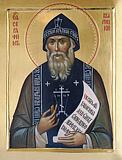

| Previous day | Next day |
| Old Style
March 21
|
Friday |
New Style
April 3
|
|
5th Week of Great Lent.
Tone 8.
Great Lent. |
Monastic rule: xerophagy (bread, uncooked fruits and vegetables).
|
![]() St. James the Confessor, bishop, of the Studion (8th c.-9th c.). St. Seraphim of Vyritsa (1949).
St. James the Confessor, bishop, of the Studion (8th c.-9th c.). St. Seraphim of Vyritsa (1949).
St. Cyril, bishop of Catania (1st c.-2nd c.). St. Thomas, patriarch of Constantinople (610). St. Pachomius, abbot, of Nerekhta (1384).
St. Beryllus, bishop of Catania (2nd c.). St. Serapion, bishop of Thmuis, Egypt (ca. 358). St. Lupicinus, desert-dweller, of the Jura Mountains (Gaul) (480). St. Enda, monk, of Aran (Ireland) (530). St. Sophronius, abbot, of the monastery of St. Theodosius in Palestine (542). New Martyr Michael of Agrapha, at Thessalonica (1544). Martyrs Philemon and Domninus of Rome. St. Serapion the Sindonite, monk, of Egypt (5th c.).
Thoughts for Each Day of the Year
According to the Daily Church Readings from the Word of God
By St. Theophan the Recluse

Friday.
The souls of the righteous are in the hand of God (Wisdom 3:1). But in whose hand are the souls of sinners? The Saviour said to the apostles that satan seeks to sift them like wheat, that is, he seeks to knock them from the right path, to take them into his hands and do with them what he wants. That is why everyone turning away from the Lord is in the hands of satan, and he sifts them and casts them wherever he desires. Due to this the heads of sinners are constantly spinning, because the enemy, dragging them here and there, does not give them a chance to come to their senses. As soon as the enemy notices that someone is starting to have second thoughts, he starts to shake him even more strongly, so that his head again becomes clouded and his thoughts become scattered.
Articles
 St. James the Confessor the Bishop of CataniaSaint James, Bishop and Confessor,was inclined toward the ascetic life from his early years. |
 St. Cyril the Bishop of CataniaSaint Cyril was born in Antioch. He was a disciple of the Apostle Peter (June 29, January 16), who installed him as Bishop of Catania in Sicily. |




